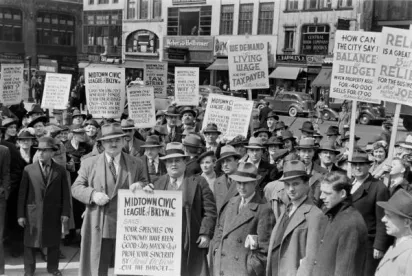As the Fair Labor Standards Act (FLSA) turns 80, it presents a timely opportunity to acknowledge its impact and call for its modernization. Signed into law on June 25, 1938, the FLSA was part of the New Deal championed by President Franklin D. Roosevelt and Secretary of Labor Frances Perkins, among many others. The law, which took effect on October 24, 1938, established a federal minimum wage of 25 cents per hour, provided for a maximum workweek of 44 hours before overtime pay was required, and prohibited oppressive child labor. This initial legislation called for reducing the workweek by two hours per week over the following two years to 40 hours before overtime pay was due. It also increased the federal minimum wage from 25 cents per hour to 40 cents per hour through annual increases over a three-year period.
As described by the Supreme Court in an early case involving the FLSA, Congress passed the FLSA “to protect certain groups of the population from sub-standard wages and excessive hours which endangered the health and well-being and the free flow of goods in interstate commerce.” The Court characterized the statute as “a recognition of the fact that due to the unequal bargaining power as between employer and employee, certain segments of the population required compulsory legislation to prevent private contracts on their part which endangered national health and efficiency and as a result the free movement of goods in interstate commerce”; it also stated that “standards of minimum wages and maximum hours were provided” to accomplish these purposes. In yet another case, the Court noted that the overtime standard was included in the FLSA in order “to spread employment by placing financial pressure on the employer” and “to compensate employees for the burden of a workweek in excess of the hours” set in section 7 of the Act. The FLSA is a significant law that Congress passed to establish some equilibrium between employers and employees by setting minimum wage and overtime standards and protecting children against hazardous work.
The FLSA has undergone numerous amendments over the last 80 years. Among the many changes to the FLSA, the Portal-to-Portal Act of 1947 is the most significant. It addressed certain employee activity to clarify what constituted hours worked under the FLSA. Other significant amendments include the following: the 2000 amendment to exclude stock options and appreciation rights from an employee’s regular rate; the Employee Commuting Flexibility Act passed in 1996; the 1990 amendment to add a computer employee exemption as section 13(a)(17); the 90-day training wage becoming effective in 1990; passage of the Equal Pay Act of 1963; the 1974 amendment extending the FLSA to domestic service workers or household employees; and a series of amendments in the 1970s that applied the FLSA to public sector employees of state and local governments and other public entities. Counting phased-in incremental increases beginning with the first increase in 1939, the federal minimum wage has increased 28 times to reach its current level of $7.25 per hour.
Even though the FLSA has included the same basic labor standards for 80 years, it has had, and continues to have, remarkable impacts upon the workplace through its basic, yet simple, requirements that employees are entitled to at least a minimum wage for all hours worked and overtime premium pay for hours worked in excess of 40 hours in a workweek. For example, FLSA litigation continues at a high pace even though the number of cases filed under the FLSA dropped in 2017 to 8,375 from an all-time high of 9,041 in 2016, according to the most recent Federal Judicial Caseload Statistics report. Also, the FLSA continues to cause compliance challenges for employers, and there are multiple reasons for these compliance issues and the increased litigation. One obvious reason is the age and “condition” of the FLSA itself. The economy and workplace of the 1930s and 1940s are a far cry from how things are today. As the country progressed from an agrarian economy to the industrial age, from the post–World War II boom to a technology-driven economy and workplace, the FLSA has failed to keep pace with these changes.
Also, despite the numerous amendments and changes to the FLSA, Congress has failed to reform and modernize the law to make it as relevant to current workplace practices and models as it was previously. At this time, Congress should overhaul the FLSA. There are numerous ways to improve the FLSA, but we will mention only four. As the economy and workplaces continue to evolve, the FLSA could establish an independent contractor-employee, operator, or provider status to accommodate today’s on-demand, or sharing, economy. These hybrid operators would be entitled to certain benefits and protections of the FLSA and other employment laws that employees enjoy—but not all of them. For example, if a company and potential operator mutually agree on a work schedule or arrangement, the operator would not be entitled to overtime premium pay but would be protected by the anti-discrimination provisions of Title VII of the Civil Rights Act.
Another area for reform is the section 13(a)(1) exemptions for executive, administrative, professional, and outside sales employees, along with the section 13(a)(17) exemption for computer employees. In this area, Congress should repeal the primary duties tests that exempt computer employees must perform, as prescribed in section 13(a)(17). Moreover, Congress should give the Secretary of Labor the authority to define and delimit the exemption for computer employees under section 13(a)(17), just as the Secretary has in section 13(a)(1) to define and delimit the exemptions for executive, administrative, professional, or outside sales employees. Alternatively, Congress could revise the section 13(a)(17) exemption to define the duties test so that computer employees may qualify for the administrative exemption in certain circumstances. Further, the outside sales employee exemption should be amended to reflect 21st century sales practices so that the Secretary can revise the duties tests to enable sales personnel who use technology to make virtual sales or who are “inside sales” personnel to qualify for the exemption.
Thirdly, Congress needs to update the section 7(i) exemption from overtime for retail or service establishments. The first way Congress can modernize the section 7(i) exemption is to add a relevant definition of the term “retail or service establishment.” The definition of that term that is used today to analyze this exemption is the definition of that term as it was used in former section 13(a)(2). Section 13(a)(2) was added to the FLSA in the 1949 amendments but subsequently was repealed in 1989. Another way Congress can modernize this exemption is to clarify that a retail concept includes the financial services industry, medical facilities, and certain types of contractors who sell and install their products, among others.
Finally, another FLSA modernization would be to include a workweek flexibility concept. This could take the form of a compensatory paid time off program that would apply to the private sector as it does to the public sector. Or, it could allow employees who work overtime in one workweek to take paid time off in a subsequent workweek. Another version could allow an employer and employee to agree to a 14-day work period of 80 hours, after which overtime would be paid for hours worked in excess of 80 during that work period.
The opportunities to update and improve the FLSA so that it is relevant to the 21st century workplace and reduces litigation are numerous. Hopefully, Congress will tackle this challenge and, through careful improvement and thoughtful amendment, the FLSA may well last another 80 years.
This is part two of a three-part series commemorating the 80th anniversary of the Fair Labor Standards Act. Part one, “The FLSA After 80 Years, Part I: Major Changes, Current Compliance Concerns, and Possible Revisions,” discusses how the FLSA has changed in the last eight decades, current areas of concern for employers, and revisions that are likely to be made in the near future.




 />i
/>i
